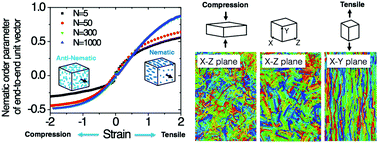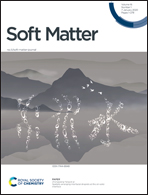Compression-induced anti-nematic order in glassy and semicrystalline polymers†
Abstract
We provide new insights into the molecular origin of the asymmetry between uniaxial tensile and compressive deformation of glassy and semicrystalline polymers using molecular dynamics simulations. The difference between the two responses strongly depends on the chain length and is the largest at intermediate chain lengths. Irrespective of chain length, the intra- and interchain organization of polymers under extension and compression are remarkably distinct. The chains align along the tensile axis leading to a global nematic order of the bonds and end-to-end vectors, whereas compression reorganizes polymers to lie in planes perpendicular to the compressive axis resulting in the emergence of an anti-nematic order and destruction of crystallinity. Regardless of the initial glassy or semicrystalline structure, the deformed state of polymers at large strains converge towards the same kind of structure that only depends on the deformation mode.



 Please wait while we load your content...
Please wait while we load your content...